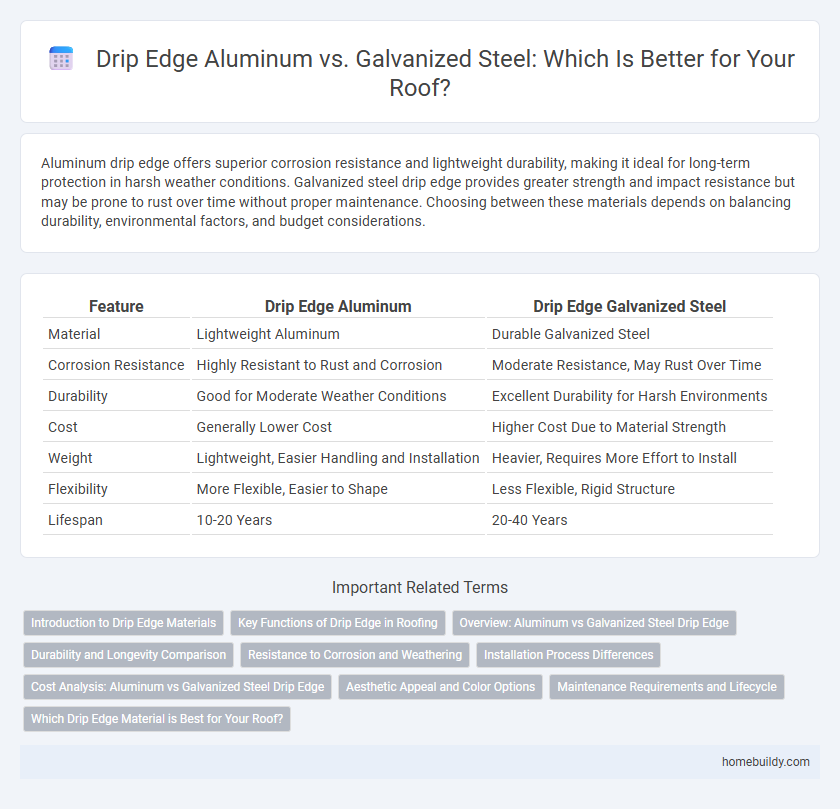Aluminum drip edge offers superior corrosion resistance and lightweight durability, making it ideal for long-term protection in harsh weather conditions. Galvanized steel drip edge provides greater strength and impact resistance but may be prone to rust over time without proper maintenance. Choosing between these materials depends on balancing durability, environmental factors, and budget considerations.
Table of Comparison
| Feature | Drip Edge Aluminum | Drip Edge Galvanized Steel |
|---|---|---|
| Material | Lightweight Aluminum | Durable Galvanized Steel |
| Corrosion Resistance | Highly Resistant to Rust and Corrosion | Moderate Resistance, May Rust Over Time |
| Durability | Good for Moderate Weather Conditions | Excellent Durability for Harsh Environments |
| Cost | Generally Lower Cost | Higher Cost Due to Material Strength |
| Weight | Lightweight, Easier Handling and Installation | Heavier, Requires More Effort to Install |
| Flexibility | More Flexible, Easier to Shape | Less Flexible, Rigid Structure |
| Lifespan | 10-20 Years | 20-40 Years |
Introduction to Drip Edge Materials
Drip edge materials commonly include aluminum and galvanized steel, each offering distinct advantages for roofing protection. Aluminum drip edge is lightweight, resistant to rust, and easy to install, making it ideal for coastal or humid environments. Galvanized steel drip edge boasts superior durability and strength, providing long-lasting protection against harsh weather and mechanical damage on roofs.
Key Functions of Drip Edge in Roofing
Drip edge aluminum offers superior corrosion resistance and lightweight durability, making it ideal for long-term protection against water infiltration at roof edges. Galvanized steel drip edge provides enhanced strength and impact resistance, which is crucial for maintaining roof integrity in harsh weather conditions. Both materials effectively direct water away from the fascia and underlayment, preventing rot and structural damage while supporting roof ventilation.
Overview: Aluminum vs Galvanized Steel Drip Edge
Aluminum drip edge offers superior corrosion resistance and lightweight properties, making it ideal for coastal or rainy environments. Galvanized steel drip edge provides enhanced strength and durability due to its zinc coating, which protects against rust in harsher weather conditions. Choosing between aluminum and galvanized steel depends on factors like climate, budget, and desired lifespan for roofing protection.
Durability and Longevity Comparison
Aluminum drip edge offers corrosion resistance, making it ideal for coastal or humid environments where moisture exposure is frequent. Galvanized steel drip edge provides superior strength and impact resistance, ensuring long-term durability in high-wind or heavy-load conditions. Both materials enhance roof edge protection, but galvanized steel generally outlasts aluminum in structural resilience, while aluminum excels in rust prevention.
Resistance to Corrosion and Weathering
Drip edge aluminum offers superior resistance to corrosion and weathering due to its natural oxide layer, making it ideal for coastal and humid environments. In contrast, drip edge galvanized steel, coated with zinc, provides strong protection but may eventually corrode when exposed to harsh weather conditions or saltwater over time. Choosing aluminum drip edge extends the longevity of roofing by reducing rust and degradation caused by moisture and environmental factors.
Installation Process Differences
Drip edge aluminum is lightweight and flexible, making it easier to cut and shape during installation, while galvanized steel requires more precise handling due to its rigidity and weight. Aluminum drip edges are typically installed using corrosion-resistant nails or screws, which helps prevent potential rust issues common with steel fasteners on galvanized steel edges. The installation of galvanized steel drip edge may involve additional steps such as aligning heavier materials and applying sealants to mitigate rust and extend lifespan, contrasting with the simpler process for aluminum.
Cost Analysis: Aluminum vs Galvanized Steel Drip Edge
Aluminum drip edge generally costs more upfront than galvanized steel but offers superior corrosion resistance and longer lifespan, reducing maintenance expenses over time. Galvanized steel drip edge is budget-friendly initially but may incur higher replacement and repair costs due to rust susceptibility in harsh weather conditions. Considering total cost of ownership, aluminum proves more economical for long-term roofing projects despite its higher initial investment.
Aesthetic Appeal and Color Options
Aluminum drip edge offers superior aesthetic appeal due to its smooth finish and availability in a wide range of color options, allowing seamless integration with various roofing styles. Galvanized steel drip edge typically comes in limited colors and may require painting for enhanced appearance, which can fade or peel over time. Choosing aluminum ensures long-lasting color retention and a cleaner, more polished look for the roofline.
Maintenance Requirements and Lifecycle
Drip edge aluminum requires minimal maintenance due to its corrosion-resistant properties, making it suitable for environments prone to moisture without frequent upkeep. Galvanized steel drip edge demands regular inspections and touch-ups to prevent rust and prolong its lifecycle, especially in humid or coastal areas. Aluminum generally offers a longer lifecycle with reduced maintenance costs compared to galvanized steel, which may corrode and degrade faster without proper care.
Which Drip Edge Material is Best for Your Roof?
Aluminum drip edge offers superior corrosion resistance and lightweight properties, making it ideal for coastal or humid environments where rust is a concern. Galvanized steel drip edge provides greater strength and durability, suitable for areas prone to heavy snow or strong winds requiring robust protection. Choosing the best drip edge material depends on balancing environmental factors, budget, and roof longevity needs.
Drip edge aluminum vs Drip edge galvanized steel Infographic

 homebuildy.com
homebuildy.com